To find the gas tank in your car, check your dashboard for an arrow or indicator on the fuel gauge, which guides you to the gas tank access. Familiarize yourself with this indicator to avoid inconvenience at the gas station. The fuel gauge may display the hose direction or side indicator, so take a quick glance to determine the gas tank location. Understanding common gas tank locations, like the left side for American cars and right side for European and Japanese cars, can also aid in navigation. By knowing where your gas tank is, you'll save time and frustration at the pump – and there's more to discover about fueling your car efficiently.
Key Takeaways
- Check your car's fuel gauge for an arrow or indicator that points to the location of the gas tank.
- Familiarize yourself with the indicator to avoid confusion at the gas station.
- The gas tank location can vary depending on the car's manufacturer and model.
- Look for a diamond-arrow icon on your fuel gauge to determine the gas tank side.
- Knowing the gas tank location can streamline the refueling process and save time.
Locating the Gas Tank
To guarantee you never get stuck at the gas station, start by checking your dashboard for an arrow or indicator on the fuel gauge, which will point you to the side of your car where the gas tank access is located. This indicator arrow is usually a small graphic, often in the shape of an arrow or a diamond, and it's specifically designed to guide you to the gas tank door.
Take a closer look at your fuel gauge, as it may also display a hose direction or a side indicator that signifies the location of the gas tank. By familiarizing yourself with this indicator, you'll avoid the inconvenience of driving around the gas station, searching for the gas tank door.
Reasons for Varied Placement
When you hop into a car, you might assume the gas tank is always on the same side, but surprisingly, it's not, and that's because car engineers carefully consider several factors when deciding where to place the fuel door.
Car engineers take into account different considerations, including vehicle design, functionality, and safety, which can influence the fuel door's placement on either side of the vehicle.
Some of the key factors that influence the placement of the fuel door include:
- Regulations, or lack thereof, as there are no specific regulations in Canada and the United States dictating the side for the fuel door placement
- Driver preferences, such as easier access to fuel pumps, which can sway the decision to mount the fuel door on the left or right side
- Other vehicle components, like the audio system, which may occupy space that could be used for the fuel door on one side, leading manufacturers to mount it on the other side instead
Gas Tank Position Indicators

Check your dashboard for a subtle indicator: a diamond-arrow on the fuel gauge, an icon showing the direction of the fuel hose, or a small arrow next to the pump icon, all of which can reveal the gas tank's location on your vehicle.
These indicators are designed to help you identify the side of the car where the gas tank is located, saving you from confusion and inconvenience at the gas station. By knowing which side the gas tank is on, you can refuel with ease and confidence.
Take a closer look at your fuel gauge, and you might notice a small icon or arrow pointing to the left or right, indicating the gas tank's position. This simple yet effective indicator can save you time and frustration, ensuring a smooth refueling experience.
Common Gas Tank Locations
You'll find that gas tanks are commonly located on either the left or right side of vehicles, with some manufacturers and models deviating from this pattern. While there's no universal standard, you can make some generalizations about gas tank locations based on the type of car you own.
- Most American-made cars have their gas tanks on the left side, which can make refueling more convenient at traditional fueling stations.
- European and Japanese cars often feature gas tanks on the right side, which may require adjustments when fueling up.
- The location of the gas tank can vary based on the manufacturer and car model, so it's essential to familiarize yourself with your vehicle's specific design.
Understanding the common locations of gas tanks can help you navigate fueling stations with confidence and avoid any confusion or inconvenience. By knowing which side your gas tank is on, you can streamline the refueling process and get back on the road more efficiently.
Determining Your Car's Gas Tank

Your car's gas tank location is easily decipherable, and a quick glance at your dashboard can give you the answer. The key to determining your car's gas tank lies in the fuel gauge, which often features a diamond-arrow icon. This icon is more than just a simple graphic; it's actually a directional indicator that points to the side of the car where the gas tank is located.
By checking the direction of the hose on the icon, you can easily determine which side of the car the gas tank is on. This simple trick can save you time and hassle at the fueling station. Before you pull up to the pump, take a quick peek at your fuel door to confirm which side the gas tank is on. By doing so, you can avoid the inconvenience of getting out of your car only to realize you're on the wrong side.
Avoiding Refueling Hassles
By parking alongside a car with a gas tank on the same side, you can avoid the hassle of waiting for a pump on the opposite side to become available. This simple strategy can save you time and frustration at the gas station. In fact, cars with gas tanks on the same side can lead to quicker refueling, making the entire process more efficient. This is because gas stations can be more organized and efficient when vehicles have tanks on the same side, reducing congestion and wait times.
Here are some benefits of having a gas tank on the same side as the pump:
- Reduces congestion at gas stations by allowing multiple cars to refuel simultaneously
- Enables a more efficient flow of traffic within the station
- Allows for a smoother, hassle-free refueling experience for drivers
Frequently Asked Questions
Where Is the Gas Held in a Car?
You're wondering where the gas is held in your car? Well, the gas is stored in a sealed container called the gas tank, which is usually located at the rear of your vehicle, holding fuel for the engine.
Is the Gas Tank on the Drivers Side?
You'll likely find the gas tank on your car's driver's side, a convenient design choice influenced by practicality and driver comfort, making refueling a breeze without having to stretch across the vehicle.
Where Is Fuel Stored in a Car?
You're wondering where fuel is stored in your car? Well, it's stored in the gas tank, which is usually located at the rear of the vehicle, safely positioned away from impact zones for your safety.
Is the Fuel Tank at the Front of the Car?
You're likely wondering if your fuel tank is at the front of your car, but it's unlikely, since front-mounted tanks are less common due to safety concerns, and most cars have them at the rear for better stability.
Conclusion
You've now mastered the art of tracking down your car's gas tank. Whether it's on the driver's side, passenger's side, or somewhere in between, you're equipped to find it with ease.
Remember to consult your owner's manual or look for visual cues if you're still uncertain. By doing so, you'll avoid refueling hassles and guarantee a smoother driving experience.
